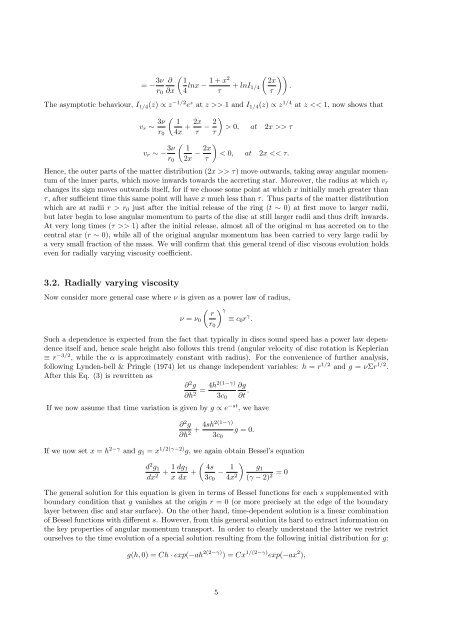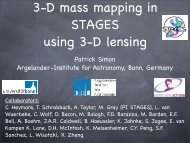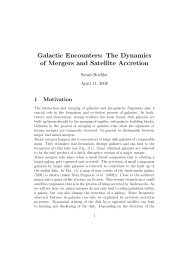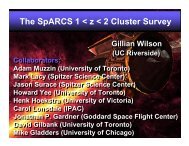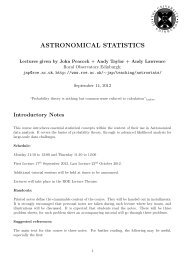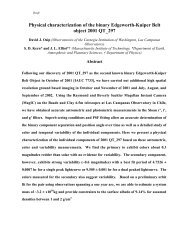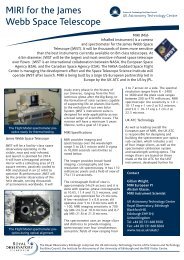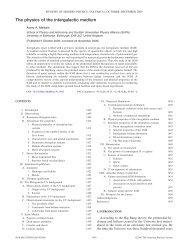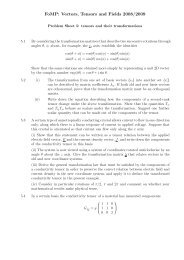Angular Momentum Transfer in Accretion Discs
Angular Momentum Transfer in Accretion Discs
Angular Momentum Transfer in Accretion Discs
You also want an ePaper? Increase the reach of your titles
YUMPU automatically turns print PDFs into web optimized ePapers that Google loves.
= − 3ν ( ( ))<br />
∂ 1 1 + x2<br />
2x<br />
lnx − + lnI 1/4 .<br />
r 0 ∂x 4 τ<br />
τ<br />
The asymptotic behaviour, I 1/4 (z) ∝ z −1/2 e z at z >> 1 and I 1/4 (z) ∝ z 1/4 at z 0,<br />
τ<br />
at 2x >> τ<br />
v r ∼ − 3ν ( 1<br />
r 0 2x − 2x )<br />
< 0,<br />
τ<br />
at 2x > τ) move outwards, tak<strong>in</strong>g away angular momentum<br />
of the <strong>in</strong>ner parts, which move <strong>in</strong>wards towards the accret<strong>in</strong>g star. Moreover, the radius at which v r<br />
changes its sign moves outwards itself, for if we choose some po<strong>in</strong>t at which x <strong>in</strong>itially much greater than<br />
τ, after sufficient time this same po<strong>in</strong>t will have x much less than τ. Thus parts of the matter distribution<br />
which are at radii r > r 0 just after the <strong>in</strong>itial release of the r<strong>in</strong>g (t ∼ 0) at first move to larger radii,<br />
but later beg<strong>in</strong> to lose angular momentum to parts of the disc at still larger radii and thus drift <strong>in</strong>wards.<br />
At very long times (τ >> 1) after the <strong>in</strong>itial release, almost all of the orig<strong>in</strong>al m has accreted on to the<br />
central star (r ∼ 0), while all of the orig<strong>in</strong>al angular momentum has been carried to very large radii by<br />
a very small fraction of the mass. We will confirm that this general trend of disc viscous evolution holds<br />
even for radially vary<strong>in</strong>g viscosity coefficient.<br />
3.2. Radially vary<strong>in</strong>g viscosity<br />
Now consider more general case where ν is given as a power law of radius,<br />
ν = ν 0<br />
( r<br />
r 0<br />
) γ<br />
≡ c 0 r γ .<br />
Such a dependence is expected from the fact that typically <strong>in</strong> discs sound speed has a power law dependence<br />
itself and, hence scale height also follows this trend (angular velocity of disc rotation is Keplerian<br />
≡ r −3/2 , while the α is approximately constant with radius). For the convenience of further analysis,<br />
follow<strong>in</strong>g Lynden-bell & Pr<strong>in</strong>gle (1974) let us change <strong>in</strong>dependent variables: h = r 1/2 and g = νΣr 1/2 .<br />
After this Eq. (3) is rewritten as<br />
∂ 2 g<br />
∂h 2 = 4h2(1−γ) ∂g<br />
3c 0 ∂t .<br />
If we now assume that time variation is given by g ∝ e −st , we have<br />
∂ 2 g<br />
∂h 2 + 4sh2(1−γ)<br />
3c 0<br />
g = 0.<br />
If we now set x = h 2−γ and g 1 = x 1/2(γ−2) g, we aga<strong>in</strong> obta<strong>in</strong> Bessel’s equation<br />
d 2 g 1<br />
dx 2 + 1 (<br />
dg 1 4s<br />
x dx + − 1 )<br />
g 1<br />
3c 0 4x 2 (γ − 2) 2 = 0<br />
The general solution for this equation is given <strong>in</strong> terms of Bessel functions for each s supplemented with<br />
boundary condition that g vanishes at the orig<strong>in</strong> r = 0 (or more precisely at the edge of the boundary<br />
layer between disc and star surface). On the other hand, time-dependent solution is a l<strong>in</strong>ear comb<strong>in</strong>ation<br />
of Bessel functions with different s. However, from this general solution its hard to extract <strong>in</strong>formation on<br />
the key properties of angular momentum transport. In order to clearly understand the latter we restrict<br />
ourselves to the time evolution of a special solution result<strong>in</strong>g from the follow<strong>in</strong>g <strong>in</strong>itial distribution for g:<br />
g(h, 0) = Ch · exp(−ah 2(2−γ) ) = Cx 1/(2−γ) exp(−ax 2 ),<br />
5


